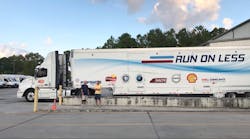Editor’s note: This is the first part of look at how fleets are achieving higher MPG on U.S. roads. Read Part 2.
Want to consume 9.7 billion fewer gallons of diesel fuel a year? It is possible, based on the results of the Run on Less program.
Spearheaded by the North American Council on Fuel Efficiency (NACFE), seven fleets achieved a cumulative average of 10.1 miles per gallon (mpg).
Covering more than 50,000 miles over 17 days, the once seemingly unattainable goal was reached using commercially available aerodynamic devices and technologies.
While today’s truck models are continually improving in terms of fuel efficiency, there remains a long way to go before most fleets come anywhere close seeing double-digit miles per gallon.
According to the American Transportation Research Institute (ATRI), overall fuel economy was 6.4 mpg in 2017, up from 6.3 mpg in 2016.
Fuel economy should continue to improve as more motor carriers replace existing trucks with newer models. However, growing highway congestion and a rising number of e-commerce deliveries to urban areas are likely to offset some of the gains.
This is already playing out in the private fleet sector. The National Private Truck Council noted in its 2018 benchmarking survey that operational demands, such as regional applications with multiple stops, make it difficult to achieve the full benefits of the newer engines and truck models.
Regardless of a truck’s specifications, speed is always one of the most important factors for fuel economy. That fact has resulted in greater use of speed governors.
Fleets using these devices reported an average fuel efficiency of 6.5 mpg, while those not using speed limiters reported fuel economy of only 5.6 mpg, according to ATRI.
Traveling at a consistent speed, whenever possible, also improves fuel efficiency. An ATRI analysis found a longer route with fewer stops will generally consume less fuel than a shorter route requiring multiple stops for traffic signals or due to congestion.
Another critical factor is weight. As a rule, each 10,000-lb. increase of a load translates into a 5% drag on fuel economy.
ATRI’s survey found fleets with loaded operating weights between 40,001 and 60,000 pounds had a fuel economy of 7.2 mpg, while fleets typically operating at weights in excess of 80,000 lbs. reported a fuel economy average of only 4.9 mpg.
Run on Less
So how were the seven fleet participants in Run on Less able to save 2,877 gallons of fuel and more than $7,000, based on the national average of 6.4 mpg?
First, “drivers took their mission seriously,” according to Mike Roeth, NACFE’s executive director.
One driver avoided going through a truck wash during Run on Less to save every last drop of diesel.
Covering 50,000 miles and 99 days of driving, the Run on Less results show that for high-mileage trucks, use “every tractor aerodynamic device you can put on it,” said Roeth.
He added it is rare to not find a payback, except potentially in cases when vehicles are going off-road.
Brent Nussbaum, CEO of truckload carrier Nussbaum Transportation, took on the Run on Less challenge to “demonstrate the success when pairing a trained and skilled driver with the latest technology in fuel efficiency.”
Nussbaum’s fleet of more than 400 trucks achieved just under 9 mpg for all of 2018, including a high of 9.37 mpg in July.
For Run on Less, Nussbaum turned to one of his most efficient drivers, Clark Reed. With more than 1.5 million safe miles already under his belt, Reed used his 2018 Freightliner Cascadia with Detroit powertrain. It featured wide-base tires and a suite of aerodynamic devices and technologies that he uses under regular conditions.
Nussbaum noted there were a couple of minor modifications, including using 29-foot trailer skirts instead of 23-foot skirts.
Editor’s note: This is the first part of look at how fleets are achieving higher MPG on U.S. roads. Tomorrow, we’ll take a look at how fuel-saving technology is becoming part of new truck models. Read Part 2.



